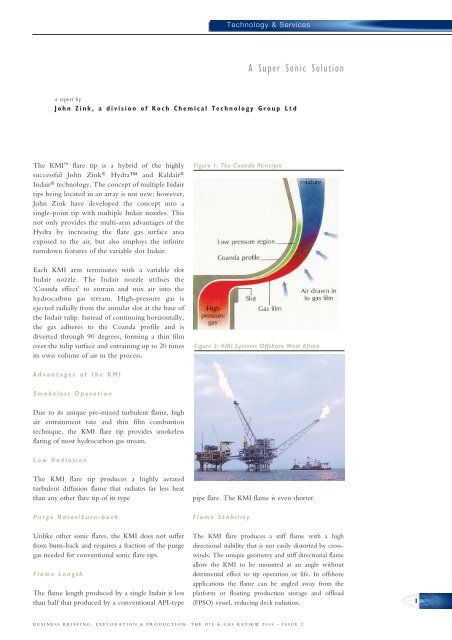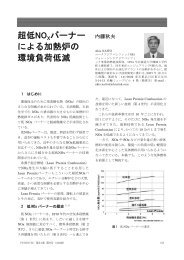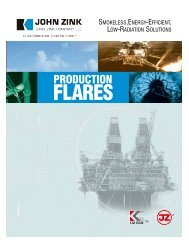A Super Sonic Solution - John Zink Company
A Super Sonic Solution - John Zink Company
A Super Sonic Solution - John Zink Company
Create successful ePaper yourself
Turn your PDF publications into a flip-book with our unique Google optimized e-Paper software.
a report by<br />
<strong>John</strong> <strong>Zink</strong>, a division of Koch Chemical Technology Group Ltd<br />
The KMI flare tip is a hybrid of the highly<br />
successful <strong>John</strong> <strong>Zink</strong> ® Hydra and Kaldair ®<br />
Indair ® technology. The concept of multiple Indair<br />
tips being located in an array is not new; however,<br />
<strong>John</strong> <strong>Zink</strong> have developed the concept into a<br />
single-point tip with multiple Indair nozzles. This<br />
not only provides the multi-arm advantages of the<br />
Hydra by increasing the flare gas surface area<br />
exposed to the air, but also employs the infinite<br />
turndown features of the variable slot Indair.<br />
Each KMI arm terminates with a variable slot<br />
Indair nozzle. The Indair nozzle utilises the<br />
‘Coanda effect’ to entrain and mix air into the<br />
hydrocarbon gas stream. High-pressure gas is<br />
ejected radially from the annular slot at the base of<br />
the Indair tulip. Instead of continuing horizontally,<br />
the gas adheres to the Coanda profile and is<br />
diverted through 90 degrees, forming a thin film<br />
over the tulip surface and entraining up to 20 times<br />
its own volume of air in the process.<br />
Advantages of the KMI<br />
Smokeless Operation<br />
Due to its unique pre-mixed turbulent flame, high<br />
air entrainment rate and thin film combustion<br />
technique, the KMI flare tip provides smokeless<br />
flaring of most hydrocarbon gas stream.<br />
Low Radiation<br />
The KMI flare tip produces a highly aerated<br />
turbulent diffusion flame that radiates far less heat<br />
than any other flare tip of its type<br />
Purge Rates/burn-back<br />
Unlike other sonic flares, the KMI does not suffer<br />
from burn-back and requires a fraction of the purge<br />
gas needed for conventional sonic flare tips.<br />
Flame Length<br />
The flame length produced by a single Indair is less<br />
than half that produced by a conventional API-type<br />
pipe flare. The KMI flame is even shorter.<br />
Flame Stability<br />
Technology & Services<br />
Figure 1: The Coanda Principle<br />
A <strong>Super</strong> <strong>Sonic</strong> <strong>Solution</strong><br />
Figure 2: KMI Systems Offshore West Africa<br />
The KMI flare produces a stiff flame with a high<br />
directional stability that is not easily distorted by crosswinds.<br />
The unique geometry and stiff directional flame<br />
allow the KMI to be mounted at an angle without<br />
detrimental effect to tip operation or life. In offshore<br />
applications the flame can be angled away from the<br />
platform or floating production storage and offload<br />
(FPSO) vessel, reducing deck radiation.<br />
BUSINESS BRIEFING: EXPLORATION & PRODUCTION: THE OIL & GAS REVIEW 2005 – ISSUE 2<br />
1
2<br />
Liquid Handling<br />
Technology & Services<br />
Figure 3: KMI Demonstrates Clean Stable<br />
Directional Flame<br />
Figure 4: 2 Million Kg/hr KMI tip supplied to Kazakhstan<br />
The KMI flare is capable of burning 25% by weight<br />
of liquid carry-over without any fall-out or smoke<br />
production whatsoever. This feature means that, in<br />
many cases, the flare may be operated without a<br />
liquid knockout drum in the HP flare line.<br />
High-pressure Operation<br />
Since the KMI flare operates at elevated pressure<br />
when burning HP gas (rather than near atmospheric<br />
pressure as with a conventional flare), significant<br />
savings in header size and knock-out vessel size may<br />
be made.<br />
Efficient Air Entrainment and<br />
Mixing<br />
Multi-point designs improve the efficiency by<br />
splitting the flow between smaller, separated<br />
cylinders of hydrocarbon gases, allowing efficient air<br />
entrainment into the flame. The unique KMI flare<br />
tip, based on the Coanda effect, forms a thin film of<br />
hydrocarbon that entrains and pre-mixes air prior to<br />
combustion. The KMI flare, in most cases, produces<br />
combustion efficiencies in excess of 99.9%.<br />
Tip life<br />
The small Indair tulips used in the KMI are of an<br />
investment cast, highly robust single part construction<br />
that, combined with the multi-nozzle design, provides<br />
extended operational life compared with other flare<br />
tips on the market.<br />
Maintenance<br />
As the KMI tulips are very small they are easily manhandled.<br />
Therefore, in the event that any tulips require<br />
changing, it can be done without the use of a crane. In<br />
addition, the replacement of an investment cast small<br />
tulip is not expensive whereas the manufacturing cost<br />
of a large tulip is relatively high.<br />
Flexibility<br />
Turndown flexibility can be enhanced further by<br />
varying the spring rates on the individual nozzles<br />
such that the flare tip can act as a staged system in<br />
itself. Thus, the tip can be set up to bring nozzles<br />
online in turn, such that at low flows only one or<br />
two nozzles will have their slots open while all the<br />
others are closed. As the pressure and flow increase<br />
then slots can open in sequence until at full flow all<br />
slots are fully open ■<br />
BUSINESS BRIEFING: EXPLORATION & PRODUCTION: THE OIL & GAS REVIEW 2005 – ISSUE 2





